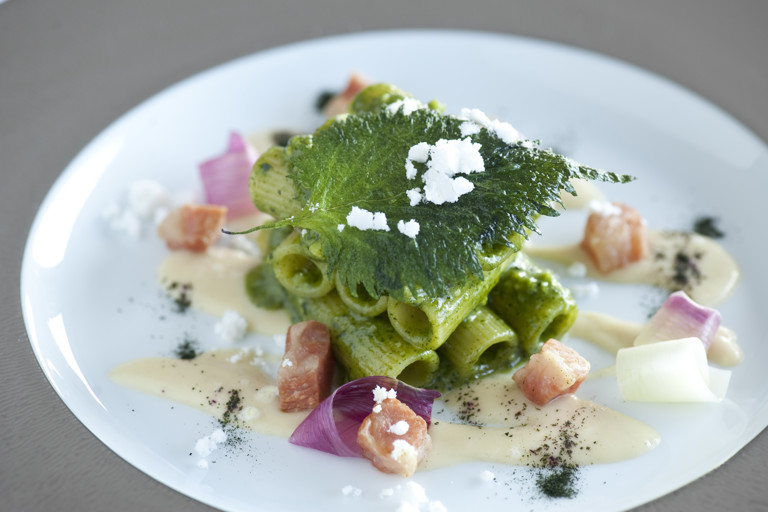Rigatoni with shiso pesto, guanciale and Amatriciana sauce
Item 1 of 1
- medium
- 4
- 1 hour 30 minutes
Francesco Apreda's verdant rigatoni recipe is colourful fusion of Italian and Japanese influences. The fragrant blend of shiso, basil and edamame beans creates an unusual pesto recipe you'll find yourself turning to again and again, while the pasta, simmered in water made from pecorino cheese, has a striking and unusual flavour of its own. Served with a blended Amatriciana sauce, crispy cubes of guanciale and a sprinkling of olive oil 'snow' this is a wonderfully intricate pasta starter.
First published in 2016
discover more:
Ingredients
Metric
Imperial
Rigatoni
- 250g of rigatoni pasta
- 250g of pecorino
- 500g of water, plus extra for cooking the pasta
- salt
Shiso pesto
Amatriciana sauce
Crispy shiso leaves
- 30g of shiso leaves
- olive oil
- salt
Olive oil powder
- 25ml of olive oil
- 200g of maltodextrin
To serve
- 300g of guanciale, cut into cubes
- 1 red onion, quartered and layers separated into petals
- dried seaweed, powdered
- olive oil
- salt
SAVE RECIPE
Equipment
- Blender
- Muslin cloth
- Thermometer
- Food processor
- Microwave
Method
1
The day before serving, begin the Amatriciana sauce. Place the tomatoes, sugar, salt and vinegar in a blender and blitz until smooth. Line a sieve with a muslin cloth and place over a bowl, then pour the blended mixture into the sieve and leave to strain for at least 10 hours to obtain a clear tomato water
- 300g of tomatoes, the chef chooses regional varieties from Italy where possible
- 2g of sugar
- 2g of salt
- 2g of white wine vinegar
2
Meanwhile, start the process of making a pecorino water to cook the pasta in. Place the pecorino and 500g of water in a blender and process until fully combined. Transfer to a pan and bring up to 80°C
- 250g of pecorino
- 500g of water, plus extra for cooking the pasta
3
Pour into a suitable container and chill for up to 1 hour, until completely cold. After this time, blend thoroughly again, heat through to 80°C and leave to chill again. Once cold, the fat from the cheese should have separated from the water – discard the fat and reserve the water for cooking the pasta later
4
Once the tomatoes for the sauce have fully strained, discard the tomato pulp and reserve the clear water. Place the guanciale in a deep frying pan and sauté gently over a medium heat to release the fat from the meat
- 150g of guanciale, chopped
5
Stir in the chopped vegetables and continue to soften gently for 5 minutes. Cover with the tomato water and and simmer for another 10–15 minutes until cooked through
- 200g of leek, finely chopped
- 150g of shallots, finely chopped
- 60g of potatoes, finely chopped
6
While simmering, make the shiso pesto. Place everything except the oil and edamame in a food processor. Blend briefly to combine, then gradually add the oil – blending continuously – until fully incorporated
7
Add the chopped edamame beans and pulse very briefly until just combined with the pesto, leaving a chunky texture. Set aside until ready to serve
- 150g of edamame, outer pods removed and beans chopped
8
Transfer the Amatriciana sauce to a blender and blitz until completely smooth. Pour into a clean pan and keep warm until ready to serve
9
To make the olive oil powder, place the oil in a bowl and gradually whisk in the maltodextrin until it forms a powder. Set aside until serving
- 25ml of olive oil
- 200g of maltodextrin
10
For the red onion garnish, blanch the petals in boiling salted water for 2–3 minutes to soften. Drain and toss with a little olive oil and salt to season. Set aside
- 1 red onion, quartered and layers separated into petals
- olive oil
- salt
11
Just before serving, bring a large pan of salted water to the boil and add the pasta. Cook for just 5–6 minutes
- 250g of rigatoni pasta
- salt
12
Meanwhile, place the cubed guanciale in a frying pan and cook over a high heat until crisp. Drain any excess oil on kitchen paper before serving
- 300g of guanciale, cubes
13
Drain the pasta, then return to the pan and cover with the reserved pecorino water, adding a splash of extra water if needed. Bring back to the boil and finish cooking the pasta for a few minutes until just al dente
14
Brush the shiso leaves with a little oil and microwave for 90 seconds. If still soft, give another 90 second blast and remove once the leaves are crisp. Season with a little salt
- 30g of shiso leaves
- olive oil
- salt
15
To serve, spoon some of the warm Amatriciana sauce over each plate. Toss the shiso pesto through the cooked pasta and divide between the plates, making a small pile or stack
16
Scatter the red onion petals and fried guanciale cubes around the plate, topping with the crisp shiso leaves. Garnish with some of the olive oil powder and a sprinkling of dried seaweed
- dried seaweed, powdered
Get in touch
Please sign in or register to send a comment to Great British Chefs.



